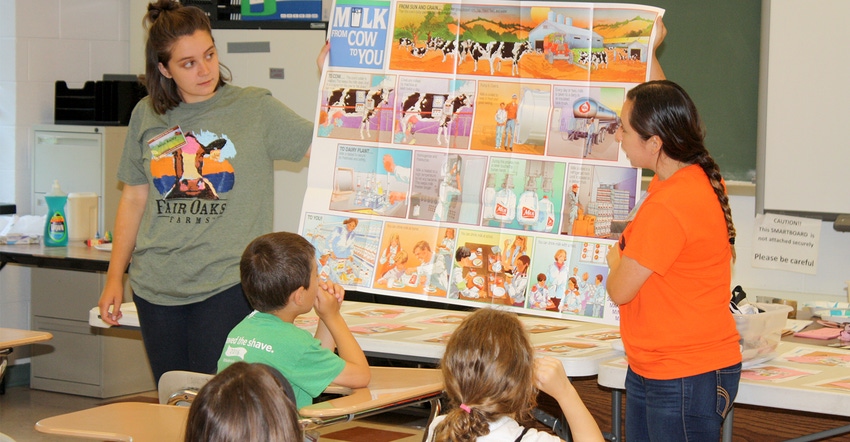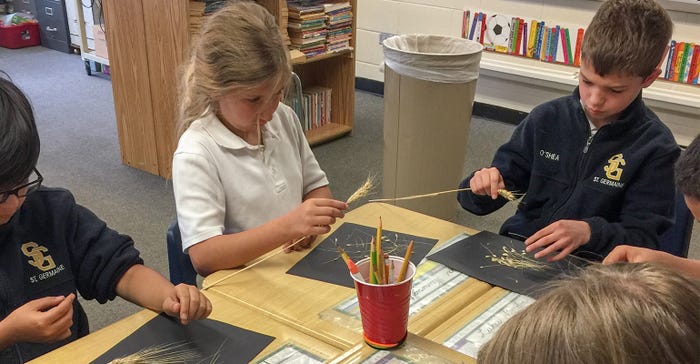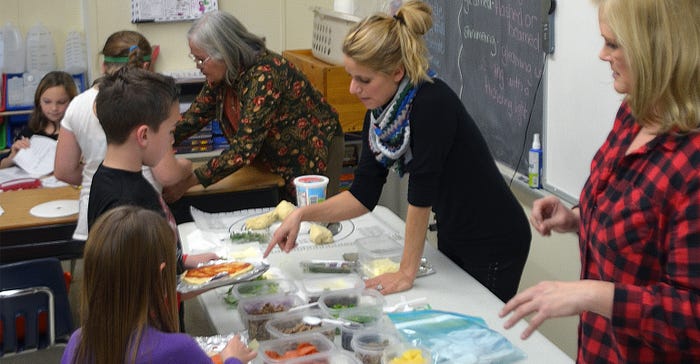
“Farmers would not wear shoes like that.”
It was a legitimate observation from a little boy who had never met a real farmer, as he looked upon Lee County, Ill., agriculture literacy coordinator Katie Pratt. What did he picture? He probably had something closer to the bib-overall-straw-hat-wearing farmer in his mind. And that might very well be the point of Ag in the Classroom: Address agricultural misconceptions, one shoe-wearing farmer at a time and, along the way, talk about where food comes from.
Opening little eyes
Kevin Daugherty, education director for Illinois Ag in the Classroom, says when you reach more than 660,000 students a year, there are too many stories, comments and questions to remember. Every coordinator is in charge of his or her own lessons and schedules, so the targeted grade levels, topics and activities may vary by county.
What’s the No. 1 myth the ag literacy coordinators tackle? Brown cows do not produce chocolate milk. “The truth is, that’s how little brains think,” Pratt notes. “They see their food in a simplistic way.”
With the overwhelming number of Cook County students, ag literacy coordinator Diane Merrion focuses her efforts on fourth-grade students studying Illinois in social studies. Merrion recalls a young man who broke down in tears after learning about the food processing industry and where his beloved bacon comes from. His taste for bacon didn’t change, she adds, but the classroom visit stuck with him until the following lesson: “I hope she doesn’t talk about pigs again.”
Harvesting animals is never an easy topic to discuss, Pratt notes, but sometimes the kids just get it. “I was able to explain the role of the farmer as caretaker to animals while they live, so in death the animal gives back to the farmer,” she explains. “One student replied, ‘It’s like a trade-off.’”
Seeing students connect the dots never gets old, Merrion adds, like when students take wheat kernels and grind them with a pepper grinder into flour. “To see that from beginning to end and to understand food doesn’t just come out of a box — those are the moments,” she notes.
 CONNECTING THE DOTS: Ag in the Classroom students at St. Germaine School, Oak Lawn, Ill., learn how wheat kernels are processed into flour. “To see that from beginning to end and to understand food doesn’t just come out of a box — those are the moments,” says Cook County ag literacy coordinator Diane Merrion.
CONNECTING THE DOTS: Ag in the Classroom students at St. Germaine School, Oak Lawn, Ill., learn how wheat kernels are processed into flour. “To see that from beginning to end and to understand food doesn’t just come out of a box — those are the moments,” says Cook County ag literacy coordinator Diane Merrion.

Tonya Holt, Fulton County coordinator, uses a variety of methods to connect with students.
“I’ve found that the more I gross the kids out, the more interested they become,” she says. “One year I did a lesson called ‘Get the Scoop on Poop,’ and we made fudge in a Ziploc bag. You can imagine how fun that was!”
Worth every minute
Some classroom visits are easier than others, Pratt notes, as she reflects on a herbicide discussion with a second-grader. “Mom says that’s poisonous and we shouldn’t be eating that,” he told Pratt. She explained how farmers are responsible for hundreds of acres and shared personal photos and stories from her own farm to help paint the big picture.
Tempting the students with pizza doesn’t hurt either, she notes. Pratt’s pizza unit breaks down all of the ingredients, explains how they relate back to the farm and ends with a class pizza party.
 PICK YOUR TOPPINGS: Students make individual pizzas after Tonya Holt (bottom right), Fulton County, Ill., ag literacy coordinator, explains the ingredients’ origins.
PICK YOUR TOPPINGS: Students make individual pizzas after Tonya Holt (bottom right), Fulton County, Ill., ag literacy coordinator, explains the ingredients’ origins.

Students remember the lesson long after the class is over, Pratt says. She ran into one of her students at the local county fair. “Are you the Mrs. Pratt that brought us pizza?” the girl asked. She introduced Pratt to her mom and then escorted them all to the barns to show off her beef and dairy breed knowledge. “That’s very rewarding,” Pratt says. “I just love it.”
Holt agrees that classroom time is worthwhile.
“The best part is the enjoyment the kids get out of learning and their excitement when they find out something new about where their food comes from,” she notes. “They are so disconnected from where their food comes from, but then the lightbulb just comes on.”
About the Author(s)
You May Also Like




